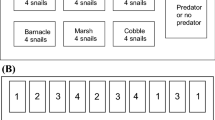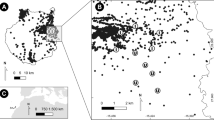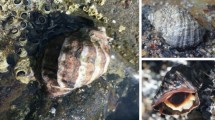Abstract
Evolution has afforded many organisms the capacity to recognize predation threats and respond accordingly with behavioral and morphological defenses. Biological invasions may obviate these coevolved recognition systems resulting in biological interactions with native species that range from novelty advantages to disadvantages for the introduced species. Predator recognition initiates responses that can affect other community members through trait-mediated indirect interactions. In this study we use the Australian invasion of a marine, predatory crab (Carcinus maenas) to determine if populations of a native whelk (Haustrum vinosum) with different histories of Carcinus invasion (no previous exposure, 20 years of exposure and 100 years of exposure) recognize and respond to the introduced crab. Haustrum were subsampled from invaded and uninvaded populations then monitored for foraging behavior, shell growth and tissue growth while maintained in a common garden setting with and without waterborne cues from Carcinus. We found that both invaded and uninvaded populations of Haustrum recognize and respond to Carcinus by reducing shell growth and foraging. In feeding experiments, Carcinus showed a preference for small whelks but not thin-shelled whelks. Our results suggest that introduced populations of Carcinus in Australia do not benefit from a novelty advantage and that the induced morphological changes in Haustrum are not a defense, per se. Haustrum’s induced behavioral response to Carcinus may be more important in reducing predation than morphological defenses, and further propagate the invasive crab’s impacts.




Similar content being viewed by others
References
Ahyong S (2005) Range extension of two invasive crab species in eastern Australia: Carcinus maenas (Linnaeus) and Pyromaia tuberculata (Lockington). Mar Pollut Bull 50:460–462
Aschaffenburg M (2008) Different crab species influence feeding of the snail Nucella lapillus through trait-mediated indirect interactions. Marine Ecol Evol Perspect 29:348–353
Bourdeau P (2011) Constitutive and inducible defensive traits in co-occurring marine snails distributed across a vertical rocky intertidal gradient. Funct Ecol 25:177–185
Brookes J, Rochette R (2007) Mechanism of a plastic phenotypic response: predator-induced shell thickening in the intertidal gastropod Littorina obtusata. J Evol Biol 20:1015–1027
Brown K, Quinn J (1988) The effect of wave action on growth in three species of intertidal gastropods. Oecologia 75:420–425
Burrows M, Hughes R (1990) Variation in growth and consumption among individuals and populations of dogwhelks, Nucella lapillus: a link between foraging behaviour and fitness. J Anim Ecol 59:723–742
Burrows M, Hughes R (1991) Variation in foraging behavior among individuals and populations of dog whelks Nucella lapillus Natural constraints on energy intake. J Anim Ecol 60:497–514
Carlton J, Cohen A (2003) Episodic global dispersal in shallow water marine organisms: the case history of the European shore crabs Carcinus maenas and C. aesuaraii. J Biogeogr 30:1809–1820
Case T, Bolger D (1991) The role of introduced species in shaping the distribution and abundance of island reptiles. Evol Ecol 5:272–290
Cox G (2004) Alien species and evolution. Island Press, Washington
Cox J, Lima S (2006) Naivete and an aquatic-terrestrial dichotomy in the effects of introduced predators. Trends Ecol Evol 21:674–680
Edgell T (2010) Past predation risk induces an intertidal whelk (Nucella lamellosa) to respond to more dilute concentrations of its predator’s scent. Mar Biol 157:215–219
Edgell T, Neufeld C (2008) Experimental evidence for latent developmental plasticity: intertidal whelks respond to a native but not an introduced predator. Biol Lett 4:385–387
Edgell T, Lynch B, Trussell G, Palmer R (2009) Experimental evidence for the rapid evolution of behavioral canalization in natural populations. Am Nat 174:434–440
Etter R (1988a) Asymmetrical developmental plasticity in an intertidal snail. Evolution 42:322–334
Etter R (1988b) Physiological stress and color polymorphism in the intertidal snail Nucella lapillus. Evolution 42:660–680
Etter R (1989) Life-history variation in the intertidal snail Nucella lapillus across a wave-exposure gradient. Ecology 70:1857–1876
Freeman A (2007) Specificity of induced defenses in Mytilus edulis and asymmetrical predator deterrence. Mar Ecol Prog Ser 334:145–153
Freeman A, Byers J (2006) Divergent induced responses to an invasive predator in marine mussel populations. Science 313:831–833
Freeman A, Hamer C (2009) The persistent effect of wave exposure on TMIIs and crab predation in Nucella lapillus. J Exp Mar Biol Ecol 372:58–63
Glude J (1954) The effects of temperature and predators on the abundance of the soft-shell clam, Mya arenaria, in New England. Trans Am Fish Soc 84:13–26
Hughes R, Elner R (1979) Tactics of a predator, Carcinus maenas, and morphological responses of the prey, Nucella lapillus. J Anim Ecol 48:65–78
Langkilde T (2009) Invasive fire ants alter behavior and morphology of native lizards. Ecology 90:208–217
Large S, Smee D (2010) Type and nature of cues used by Nucella lapillus to evaluate predation risk. J Exp Mar Biol Ecol 396:10–17
Large S, Smee D, Trussell G (2011) Environmental conditions influence the frequency of prey responses to predation risk. Mar Ecol Prog Ser 422:41–49
Leonard G, Bertness M, Yund P (1999) Crab predation, waterborne cues, and inducible defenses in the blue mussel, Mytilus edulis. Ecology 80:1–14
Marko P, Palmer A (1991) Responses of a rocky shore gastropod to the effluents of predatory and non-predatory crabs avoidance and attraction. Biol Bull 181:363–370
Palmer A (1982) Growth in marine gastropods: a non-destructive technique for independently measuring shell and body weight. Malacologia 23:63–73
Palmer A (1990) Effect of crab effluent and scent of damaged conspecifics on feeding, growth, and shell morphology of the Atlantic dogwhelk Nucella lapillus (L.). Hydrobiologia 193:155–182
Parker J, Burkepile D, Hay M (2006) Opposing effects of native and exotic herbivores on plant invasions. Science 311:1459–1461
Phillips B, Shine R (2004) Adapting to an invasive species: toxic cane toads induce morphological change in Australian snakes. Proc Natl Acad Sci USA 101:17150–17155
Rehage J, Dunlop K, Loftus W (2009) Antipredator responses by native mosquitofish to non-native cichlids: an examination of the role of prey naivete. Ethology 115:1–11
Relyea R (2001) Morphological and behavioral plasticity of larval anurans in response to different predators. Ecology 82:523–540
Rochette R, Doyle S, Edgell T (2007) Interaction between an invasive decapod and a native gastropod: predator foraging tactics and prey architectural defenses. Mar Ecol Prog Ser 330:179–188
Ross D, Johnson C, Hewitt C, Ruiz G (2004) Interaction and impacts of two introduced species on a soft-sediment marine assemblage in SE Tasmania. Mar Biol 144:747–756
Sanford E, Worth D (2009) Genetic differences among populations of a marine snail drive geographic variation in predation. Ecology 90:3108–3118
Sax D, Stachowicz J, Brown J et al (2007) Ecological and evolutionary insights from species invasions. Trends Ecol Evol 22:465–471
Schmitz O, Vlastimil K, Ovadia O (2004) Trophic cascades: the primacy of trait-mediated indirect interactions. Ecol Lett 7:153–163
Seeley R (1986) Intense natural selection caused a rapid morphological transition in a living marine snail. Proc Natl Acad Sci 83:6897–6901
Sharples C (2006) Indicative mapping of tasmanian coastal vulnerability to climate change and sea level rise: explanatory report and maps. Consultant report to Department of Primary Industries and Water, 2nd ed, Tasmania, Hobart
Sih A, Bolnick D, Luttbeg B et al (2010) Predator–prey naïveté, antipredator behavior, and the ecology of predator invasions. Oikos 119:610–621
Smee D, Weissburg M (2006) Clamming up: environmental forces diminish the perceptive ability of bivalve prey. Ecology 87:1587–1598
Strauss S, Lau J, Carroll S (2006) Evolutionary responses of natives to introduced species: what do introductions tell us about natural communities? Ecol Lett 9:357–374
Tanner J (2007) The influence of introduced European green crabs (Carcinus maenas) on habitat selection by juvenile native blue crabs (Portunus pelagicus). Estuaries Coasts 30:601–606
Thresher R, Proctor C, Ruiz G et al (2003) Invasion dynamics of the European shore crab, Carcinus maenas, in Australia. Mar Biol 142:867–876
Trussell G (2000a) Predator-induced plasticity and morphological trade-offs in latitudinally separated populations of Littorina obtusata. Evol Ecol Res 2:803–822
Trussell G (2000b) Phenotypic clines, plasticity, and morphological trade-offs in an intertidal snail. Evolution 54:151–166
Trussell G (2002) Evidence of countergradient variation in the growth of an intertidal snail in response to water velocity. Mar Ecol Prog Ser 243:123–131
Trussell G, Nicklin M (2002) Cue sensitivity, inducible defense, and trade-offs in a marine snail. Ecology 83:1635–1647
Trussell G, Smith L (2000) Induced defenses in response to an invading crab predator: an explanation of historical and geographic phenotypic change. Proc Natl Acad Sci USA 97:2123–2127
Trussell G, Ewanchuk P, Bertness M (2003) Trait-mediated effects in rocky intertidal food chains: predator risk cues alter prey feeding rates. Ecology 84:629–640
Trussell G, Ewanchuk P, Bertness M, Silliman B (2004) Trophic cascades in rocky shore tide pools: distinguishing lethal and nonlethal effects. Oecologia 139:427–432
Trussell G, Ewanchuk P, Matassa C (2006a) The fear of being eaten reduces energy transfer in a simple food chain. Ecology 87:2979–2984
Trussell G, Ewanchuk P, Matassa C (2006b) Habitat effects on the relative importance of trait- and density-mediated indirect interactions. Ecol Lett 9:1245–1252
Vadas R Sr, Burrows M, Hughes R (1994) Foraging strategies of dogwhelks, Nucella lapillus (L.): interacting effects of age, diet and chemical cues to the threat of predation. Oecologia 100:439–450
Van Buskirk J (2000) The costs of an inducible defense in anuran larvae. Ecology 81:2813–2821
Van Buskirk J (2002) Phenotypic lability and the evolution of predator-induced plasticity in tadpoles. Evolution 56:361–370
Vermeij G (1982) Phenotypic evolution in a poorly dispersing snail after arrival of a predator. Nature 299:349–350
Walton W, MacKinnon C, Rodriguez L et al (2002) Effect of an invasive crab upon a marine fishery: Green crab, Carcinus maenas, predation upon a venerid clam, Katelysia scalarina, in Tasmania (Australia). J Exp Mar Biol Ecol 272:171–189
Whitlow W (2010) Changes in survivorship, behavior, and morphology in native soft-shell clams induced by invasive green crab predators. Mar Ecol 31:418–430
Acknowledgments
Support was provided by an ARCIF grant to J.W., A.F., C.H. and M.C. In-kind support and facilities were provided by AMC/UTas, Launceston. Fellowship support was provided by UNH SURF to K.S. Valuable assistance was provided by I. Jermyn, L. Gregory, S. Partridge, J. Strugarek, and A. Tyson.
Author information
Authors and Affiliations
Corresponding author
Electronic supplementary material
Below is the link to the electronic supplementary material.
Rights and permissions
About this article
Cite this article
Freeman, A.S., Wright, J.T., Hewitt, C.L. et al. A gastropod’s induced behavioral and morphological responses to invasive Carcinus maenas in Australia indicate a lack of novelty advantage. Biol Invasions 15, 1795–1805 (2013). https://doi.org/10.1007/s10530-013-0409-z
Received:
Accepted:
Published:
Issue Date:
DOI: https://doi.org/10.1007/s10530-013-0409-z




